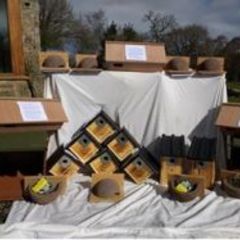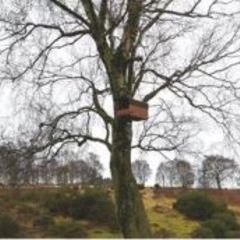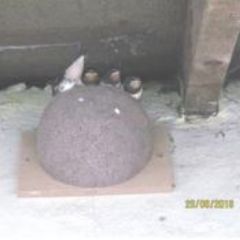Introduction
This report describes the work undertaken by the Clee Hill Community Wildlife Group during 2018.
Bird Group
LAPWING & CURLEW SURVEY
and the Save our Curlews campaign
If the haunting, bubbling, song of the Curlew fills you with the joys of spring, then please help. We have been looking for local Curlews since 2012. There were around 13 pairs in 2012, but we found only 7, but perhaps up to 3 more, in 2018 (a substantial decline in only seven years). They are in danger of disappearing altogether, and we need to know more about them before we can try to save them.
We therefore co-operated with the County-wide Save our Curlews campaign, run by Shropshire Wildlife Trust and Shropshire Ornithological Society, and funded by a joint appeal.
Farmers with Curlews on their land in 2017 were contacted and briefed about a project to find Curlew nests and protect them with an electric fence, and fit radio tags to chicks when they hatched, to see where they went and if they survived. The farmers were all very supportive, and 3 nests were found and protected. It worked well, as eggs hatched in all three. At least one, probably two, chicks survived and fledged. We learnt a great deal, and want to repeat the project in 2019.
We found 2-4 pairs of breeding Lapwings, the same as last year, which were the first for 3 years. Kestrels, in decline elsewhere, seem to be holding their own here: a pair raised 3 young in one of the Group’s Barn Owl nest boxes, and two other known nest sites were re-occupied. Red Kites are increasing, but we are not aware of any nest sites yet.
A full bird survey report for 2018 has been sent to all participants. It can also be found on the website. Twenty-five local people helped with the survey in 2018, but we need more helpers, please. It only takes three half-days to suit you, around 1st April, 1st May and mid-June. Clear guidance is provided, and it’s enjoyable and easy to do.
The Save our Curlews project will only take place in the Clee Hill area if the appeal raises sufficient funds in the next few weeks. Please consider if you feel able to make a donation. If so, visit the website, www.shropshirewildlifetrust.org.uk/appeals. If you are a UK taxpayer, please sign the Gift Aid declaration, which increases the value of your donation by 25%.
If you see a Curlew, Lapwing, Kestrel or Barn Owl in the area please tell Chris Bargman on 01299 270514, email chwg.birdgroup@gmail.com
Contact Chris also if you want further information about Bird Group activities.
Written by Leo Smith
REREGRINE GROUP
Report for 2018
After the killing of the adult birds and the successful rescue of the chicks in 2017, it was not clear what the future held for peregrines on Clee Hill. However, within ten days a new pair were in place, an adult female and a young male.
Over the winter of 2017-2018 the birds stayed in place and made the area their territory. The male developed his adult plumage with just the odd trace of brown plumage on his primaries. They survived the snows of December and the worst the weather could throw at them. They were seen mating in March and it looked like that there was the chance of a successful outcome for the year.
Unfortunately, like the rest of the country, they were hit by “The Beast from the East” during the mating period. As the weather improved, it became apparent that the birds had chosen a scrape site and were settling down for the process of laying, hatching and raising their young. The Peregrine Group’s team of volunteers were out patrolling the hill and checking on activity in the area. The new cameras were in operation and some volunteers even stayed overnight in their camper vans when it was thought the birds might be at their most vulnerable.
However, it became apparent at the beginning of June when the first signs of chicks were expected that all was not well. It soon became obvious that the female had abandoned the nest. Careful observations over the next week confirmed this. Without retrieving the eggs from the scrape the reason for the failure are speculation. However, the most probable causes could have been the very poor weather during the mating period or the immature state of the male. The birds are still present and have observed all over the winter period. Hopefully they will have a more successful season this year.
Nest Box Scheme
In 2018 the group obtained a grant from the Ludlow Rotary Club Cares fund for nest box schemes in the Clee Hill area for Kestrels, Pied Fly Catchers, Redstarts, Swifts, Swallows and House Martins. A total of 26 boxes were purchased. These were offered to people within the area who had suitable locations for the target species.

Redstart and Pied Flycatcher
6 boxes have been installed. Feedback to date shows that some of these were used but unfortunately not by target species – Blue Tits and one wasp nest. 1 box is waiting to be allocated when a suitable location where the target species have been seen can be identified.

Kestrel boxes
2 Boxes have been installed, 1 on Catherton Common and 1 at Whatshill. Kestrels have been seen in these areas but the boxes were not used last year. 1 further box is available when a suitable location has been found.

Swallow, House Martin, Swift
7 Swallow, 7 House Martin and 3 Swift Boxes have been installed at suitable locations where the target species have been seen or have previously nested. Feedback to date has indicated that there has been some success, particularly with the Swallow cups, and we are hopeful that this second season will see more of the boxes being used.
The Future
Some of the major projects that CHCWG has been a part of have been completed or are coming to a close. CHCWG will however continue in 2019 and hopefully beyond. But it needs more local people with enthusiasm and ideas to get involved and carry it forward.
If you feel you would like to become involved and contribute to that future please contact the current chair Sue Dawes.